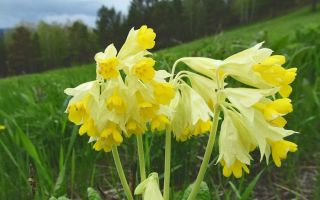Content
Primrose medicinal spring - a valuable plant with numerous useful properties. Primrose is used for colds, inflammation and vitamin deficiency, relieve pain and swelling with it.
What it looks like and where it grows
Spring primrose, heavenly keys, or primrose (Primula veris), is a herbaceous perennial from the Primroses family with short horizontal roots and a rosette of leaves.
The plates of the plant are oblong-ovate, serrated at the edges, with a wrinkled surface. They are located at the very surface of the earth with a narrowing into a petiole; during the period of decorativeness, a thin peduncle rises from the center of the rosette up to 30 cm in height. The buds of the spring primrose are yellow, with a toothed calyx and blunt rounded petals. Usually inclined to one side and collected in small drooping umbrellas up to 30 pieces.
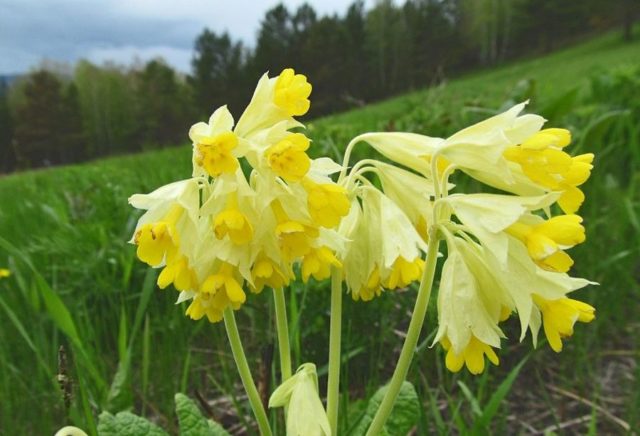
The medicinal plant is ubiquitous in Europe, in Turkey and Iran, in the Caucasus and in the central regions of Russia. You can see it in forests and forest-steppe, in meadows, glades and forest edges.
Chemical composition
In the green parts and roots of the spring medicinal primrose, or primrose, there are components valuable for the human body. Namely:
- flavonoids and essential oils;
- saponins and glycosides;
- tannins;
- vitamin C;
- retinol;
- silicic acid;
- carotene;
- tocopherol;
- manganese.
Not all components in medicinal primrose are safe for health. It is necessary to use the plant in small dosages in accordance with proven recipes.
Useful properties of medicinal spring primrose
Medicinal primrose is used to relieve acute conditions and for preventive health promotion. The valuable properties of the primrose have a beneficial effect on the human body. In particular, the plant:
- has an antispasmodic effect and soothes pain;
- due to its diuretic properties, it eliminates edema and removes toxins from tissues;
- helps with constipation and flatulence, sluggish digestion;
- has a beneficial effect on the nervous system and normalizes sleep;
- relieves rheumatism, arthritis and gout;
- prevents the development of vitamin deficiency and anemia;
- reduces high fever for colds;
- improves the condition of blood vessels and regulates the work of the cardiac system;
- effectively removes phlegm from the bronchi and lungs;
- softens coughing attacks with tracheitis and whooping cough.
You can use spring primrose to protect your eyesight, with migraines and dizziness.
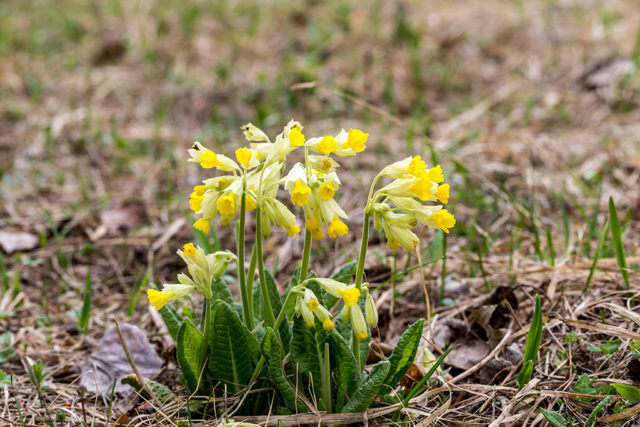
Preparation and application methods
On the basis of medicinal primrose, folk medicine suggests preparing useful water decoctions and infusions, alcoholic tinctures and ointments for skin treatment.You can use both independently collected raw materials and herbs purchased at a pharmacy to create healing products.
Decoction
Spring primrose decoction is beneficial for coughs, sore throat, and bacterial airway processes. A healing agent is prepared according to the following algorithm:
- Two large spoons of dry grass are finely cut and poured with boiling water in the volume of a glass.
- Warm up over low heat for two minutes.
- Remove from the stove and leave for another 20 minutes under the lid.
- Filter off the sediment and cool.
In a warm form, the broth is taken three times a day, a large spoonful. The drug is most effective when consumed on an empty stomach.
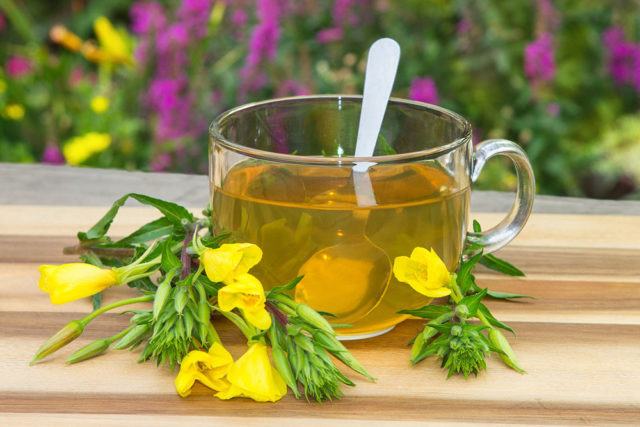
Tincture
An alcoholic tincture of the roots and shoots of medicinal primrose has pronounced analgesic, sedative and expectorant properties. You can prepare it according to the following recipe:
- 100 g of dry raw materials are poured into a glass container and 500 ml of 70% medical alcohol is poured.
- For two weeks, remove the drug in a dark place.
- The jar is removed daily to shake well.
The finished tincture is filtered and consumed three times a day, 20 drops on an empty stomach. Since the product is very strong and can burn mucous membranes, it should first be diluted in a small amount of water.
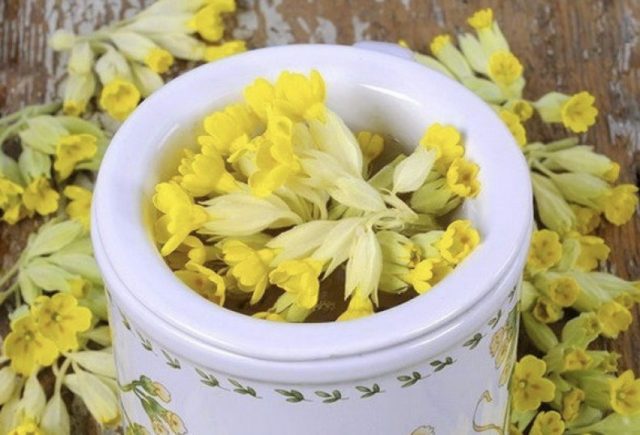
Infusion, tea
For coughs and gum disease, an aqueous infusion of medicinal primrose is recommended for use. They do it according to the following scheme:
- Dry grass plants are crushed in a volume of 15 g.
- Pour raw materials with 250 ml of fresh boiling water.
- Leave under the lid for about an hour and then filter.
The finished infusion is taken in a glass twice a day. In case of colds, it is recommended to preheat the product so that it is warm, but not scalding.
Spring primrose tea is allowed to be used with a breakdown and lack of vitamins. The cooking recipe looks like this:
- 5 g of crushed dry root is poured with 250 ml of hot liquid.
- Bring the product to a boil on the stove and immediately remove from the heat.
- In the closed form, insist for another five minutes.
Strained tea can be consumed 250 ml up to three times a day.

Fresh Juice
Most of the active components contain juice from fresh leaves and roots of medicinal primrose. Get it like this:
- The collected plant raw materials are thoroughly washed from dust and dirt.
- Chop leaves and stems and load them into a blender.
- Grind greens to a homogeneous state.
- Pass the gruel through cheesecloth to squeeze out the pure juice.
You need to take the product 15 ml twice a day on an empty stomach. Spring primrose has a particularly good effect during the recovery period after severe illness or surgery.
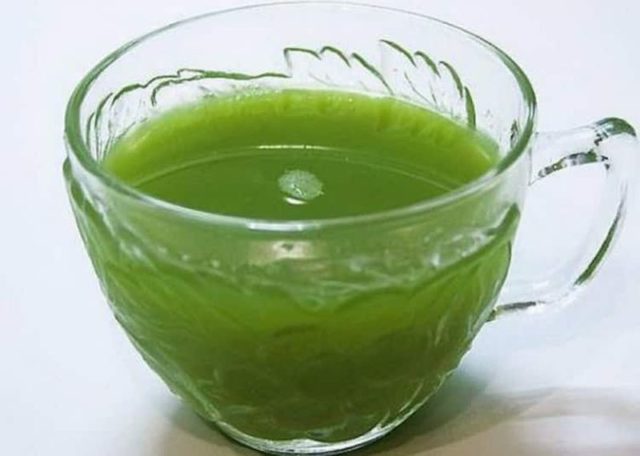
Ointment
For joint diseases, as well as for wounds, cuts and irritations, it is most convenient to use an ointment with the addition of medicinal primrose. At home, they do it like this:
- Melt in a water bath 250 g of petroleum jelly or butter.
- Add 30 g of primrose leaves, previously ground into powder.
- Mix the components thoroughly and heat over low heat for two hours.
The liquid finished product is passed through cheesecloth to separate the sediment, and then cooled at room temperature and put into the refrigerator until it solidifies completely. It is necessary to apply the ointment for compresses and rubbing for joint ailments and bruises.
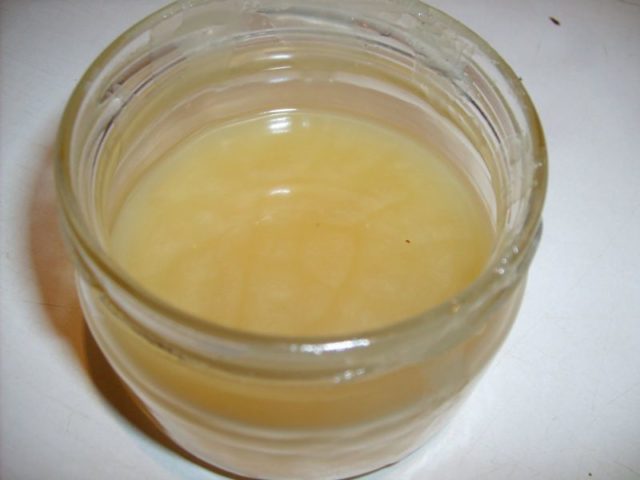
The use of medicinal spring primrose
Traditional medicine widely uses spring primrose for systemic disorders in the body and acute diseases. The plant must be used with caution and according to recipes, but if the rules are followed, it gives a good effect.
With weakened immunity
With vitamin deficiency, weak immunity and a tendency to frequent colds, it is recommended to prepare an infusion of spring primrose flowers. They do it like this:
pour 250 g of dry raw materials with 1 liter of hot water;
- Cover the container with a lid and leave to infuse for half an hour.
- Filter out the sediment.
- Add honey or sugar to taste.
You need to take the infusion three times a day, 100 ml. In total, the use of the drug continues for 2-3 weeks.
When coughing
Medicinal primrose promotes expectoration, fights bacterial processes in the respiratory organs and accelerates recovery from bronchitis, tracheitis and pneumonia. For medicinal purposes, the following infusion is prepared:
- Two large tablespoons of dry leaves of spring primrose pour 400 ml of hot liquid.
- Leave it closed for 20 minutes.
- Pass through a gauze filter.
You need to take the product in a warm form, 100 ml four times a day. The treatment continues for a week, while the infusion must be prepared anew every day.
With increased eye fatigue
Spring primrose relieves eye fatigue and protects against the development of myopia. Traditional medicine recommends the following infusion for use:
- 30 g of dry primrose leaves are poured into a thermos.
- Pour raw materials with 500 ml of boiling water and close with a lid.
- Leave to infuse for two hours.
- They are filtering.
The infusion is taken half a glass three times a day. It is recommended to combine internal use with instilling a couple of drops into the eyes before bedtime. With prolonged use, primrose can slightly improve impaired vision.
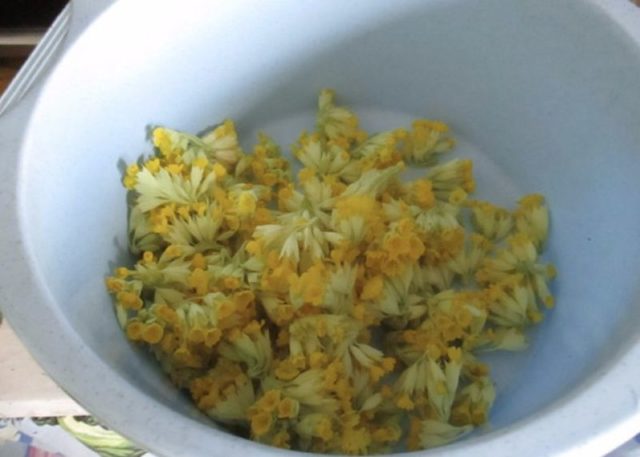
With a cold
Medicinal primrose has good antiviral properties and helps to cope with SARS and influenza. For colds, it is recommended to prepare a decoction from the roots of the plant. The recipe looks like this:
- 30 g of dried rhizomes are crushed and poured into a glass of liquid.
- The mixture is heated in a water bath for half an hour.
- Cool and filter from sediment.
- Add clean water to the original volume.
The broth should be taken three times a day, 70 ml. It is advisable to warm it up before use.
With migraine
Spring primrose relieves vasospasm and helps get rid of severe headaches. The following remedy brings a good effect:
- A large spoonful of crushed leaves and flowers is poured with boiling water in the volume of a glass.
- Insist under the lid until it cools.
- Filter through cheesecloth.
- The infusion should be taken 15 ml up to six times a day.
With whooping cough
A decoction of medicinal primrose thins phlegm and relieves dry cough with whooping cough. The remedy for internal use is prepared as follows:
- 20 g of dry herb of spring primrose is poured into 200 ml of liquid.
- Simmer for 20 minutes over low heat.
- Cool and filter.
The drug is drunk up to four times a day in a large spoon.
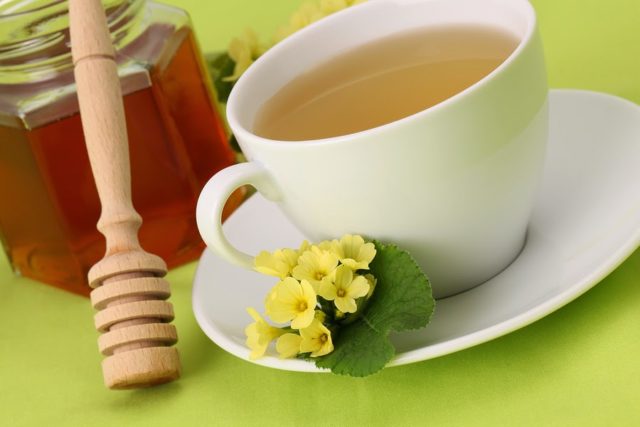
With rheumatism
The anti-inflammatory properties of medicinal primrose help to cope with pain and joint swelling in rheumatism. For therapy, such a remedy is prepared:
- 10 g of dried plant leaves are ground into powder.
- Pour raw materials 200 ml of boiling water and leave under the lid for half an hour.
- At the end of the period, filter from the sediment.
The infusion should be drunk up to four times a day, a large spoonful. For severe pain, it is also recommended to use a warm preparation for compresses.
For constipation
Medicinal primrose has laxative properties and helps relieve chronic constipation. An agent for improving peristalsis is prepared as follows:
- 25 g of dried primrose flowers are poured into a glass of hot water.
- Leave for half an hour under the lid for infusion.
- Pass through cheesecloth to remove sediment.
The cooled infusion is drunk three times a day on an empty stomach, 200 ml each.
Contraindications to the use of spring primrose
The beneficial properties of spring primrose are combined with its potential harm. It is necessary to refuse to use the plant:
- with psoriasis;
- with individual intolerance;
- during pregnancy and lactation;
- with epilepsy;
- with serious mental illness.
Since the composition of medicinal primrose contains a large amount of organic acids, the plant should not be consumed in case of peptic ulcer disease and acute pancreatitis. With caution, herbal remedies are taken in the presence of kidney stones, diuretic decoctions and infusions can cause the stones to move and cause severe pain.
Collection and procurement
Harvesting of medicinal primrose is carried out throughout the season. The buds and leaves with stems are cut at the very beginning of flowering, and the root is dug out of the soil in early spring or late autumn.
The prepared primrose raw materials are washed from contamination, and then laid out under a canopy in the air or dried in a warm room. It is allowed to use the oven to speed up the process, but the temperature should be set no more than 45-50 ° C.
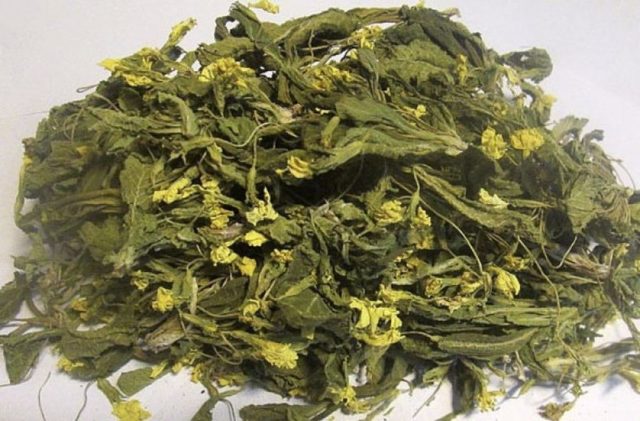
Conclusion
Primrose medicinal spring - a plant with numerous valuable properties. Most often, the herb is used for diseases of the respiratory organs and with a strong cough. But primrose also benefits from joint and digestive ailments.

